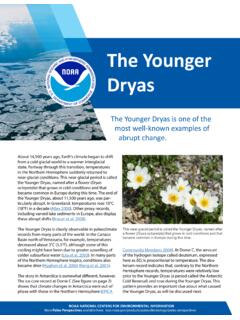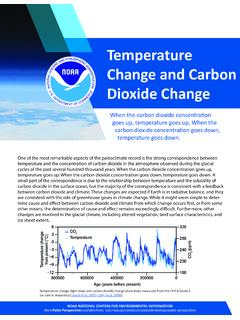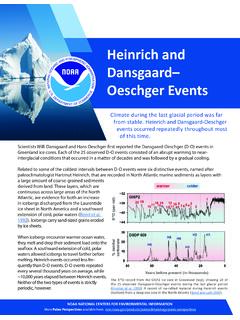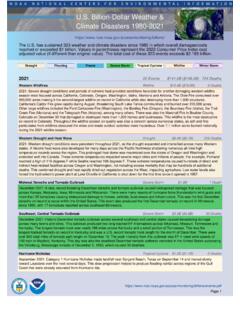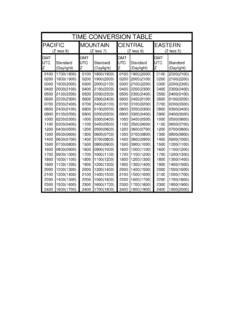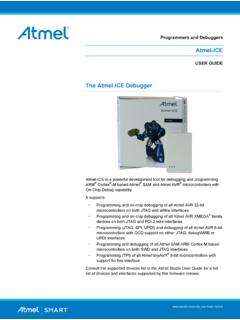Transcription of NOAA National Environmental Satellite, Data, and ...
1 NOAA National CENTERS FOR Environmental INFORMATIONG lacial-Interglacial CyclesLarge, continental ice sheets in the Northern Hemisphere have grown and retreated many times in the past. We call times with large ice sheets glacial periods (or ice ages) and times without large ice sheets interglacial periods. The most recent glacial period occurred between about 120,000 and 11,500 years ago. Since then, Earth has been in an interglacial period called the Holocene. Glacial periods are colder, dustier, and generally drier than interglacial periods. These glacial interglacial cycles are apparent in many marine and terrestrial paleoclimate records from around the world. What causes glacial interglacial cycles?Variations in Earth s orbit through time have changed the amount of solar radiation Earth receives in each season. Interglacial periods tend to happen during times of more intense summer solar radiation in the Northern Hemisphere.
2 These glacial interglacial cycles have waxed and waned throughout the Quaternary Period (the past million years). Since the middle Quaternary, glacial interglacial cycles have had a frequency of about 100,000 years (Lisiecki and Raymo 2005). In the solar radiation time series, cycles of this length (known as eccentricity ) are present but are weaker than cycles lasting about 23,000 years (which are called precession of the equinoxes ).Comparison between summer ice coverage from 18,000 years BP (see, for example, Peltier 1994) and modern day observations. Note that when more water is locked up in ice, more land is exposed due to lower sea Paleo Perspectives available here: periods tend to occur during periods of peak solar radiation in the Northern Hemisphere summer. However, full interglacials occur only about every fifth peak in the precession cycle.
3 The full explanation for this observation is still an active area of research. Nonlinear processes such as positive feedbacks within the climate system may also be very important in determining when glacial and inter-glacial periods interesting fact is that temperature variations in Antarctica are in phase with solar radiation changes in the high northern latitudes. Solar radiation changes in the high southern latitudes near Antarctica are actually out of phase with temperature changes, such that the coldest period during the most recent ice age occurred at about the time the region was ex-periencing a peak in local sunshine. This means that the growth of ice sheets in the Northern Hemisphere has an important influence on climate radiation varies smoothly through time (top, orange line) with a strong cyclicity of ~23,000 years, as seen in this time series of July incoming solar radiation at 65 N (Berger and Loutre 1991).
4 In contrast, glacial interglacial cycles last ~100,000 years (middle, black line) and consist of stepwise cooling events followed by rapid warmings, as seen in this time series inferred from hydrogen isotopes in the Dome Fuji ice core from Antarctica (Kawamura et al. 2007). Atmospheric CO2 measured from bubbles in Dome Fuji ice (bottom, blue line) shows the same pattern as the temperature time series (Kawamura et al. 2007). Yellow columns indicate interglacial do glacial periods end abruptly?Notice the asymmetric shape of the Antarctic temperature record (black line), with abrupt warmings shown in yellow preceding more gradual coolings (Kawamura et al. 2007; Jouzel et al. 2007). Warming at the end of glacial periods tends to happen more abruptly than the increase in solar insolation. Several positive feedbacks are respon-sible for this. One is the ice-albedo feedback.
5 A second feedback involves atmospheric CO2. Direct measure-ment of past CO2 trapped in ice core bubbles shows that the amount of atmospheric CO2 decreased during glacial periods (Kawamura et al. 2007; Siegenthaler et al. 2005; Bereiter et al. 2015), in part because the deep ocean stored more CO2 due to changes in either ocean mixing or biological activity. Lower CO2 levels weakened the atmosphere s greenhouse effect and helped to maintain lower temperatures. Warming at the end of the glacial periods liberated CO2 from the ocean, which strengthened the atmosphere s greenhouse effect and contributed to further important datasets related to glacial/interglacial cycles: Berger and Loutre (1991), calculated incoming solar radiation for the last 5 million years Peltier (1994), ice sheet topography since the last glacial maximum Lisiecki and Raymo (2005), benthic 18O records used as a proxy for global ice volume Siegenthaler et al.
6 (2005), carbon dioxide from the EPICA Dome C ice core in Antarctica Jouzel et al. (2007), stable isotopes from the EPICA Dome C ice core in Antarctica Kawamura et al. (2007), stable isotopes and trace gases from the Dome Fuji ice core Bereiter et al. (2015), carbon dioxide from the EPICA Dome C ice core in Antarctica@NOAANCEI@NOAANCEI and @NOAAS atellites@NOAAData and @NOAAS atellitesOctober 2021 Growth of ice sheets in the Northern Hemisphere has an important influence on climate worldwide.
